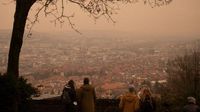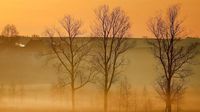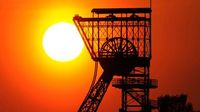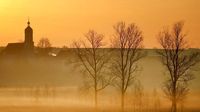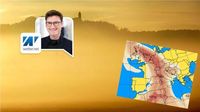In a startling meteorological event, Germany is bracing for a dramatic weather phenomenon this weekend, characterized by the arrival of Saharan dust. Set to create what meteorologists are calling "blood rain," this unusual combination of dust and rain is expected to affect various regions, notably the southwest of Baden-Württemberg.
The German Weather Service (DWD) has issued warnings regarding this weather anomaly, with predictions for March 22, 2025, indicating that rain mixed with Saharan dust could visibly stain cars, posing risks especially for car owners. As a spokesperson for the DWD explained, the blood rain is anticipated to lead to a yellowish tinge in the sky, already evidenced by the presence of thin and thick clouds holding a yellow shimmer.
These changes in the weather are not merely aesthetic; meteorologists note that thunderstorms may also develop due to the mixing air masses as this Saharan dust interacts with local weather conditions. A major shift from the pleasantly warm temperatures of Friday, March 21, when some areas like Baden-Württemberg expect highs of around 22 degrees Celsius, precedes this impending weather, which will see temperatures plummet to approximately 10 degrees in some places by Sunday, March 23.
This Saharan dust cloud is not new to the region but its earlier arrival and more intense concentration have caught meteorologists off guard. According to Dominik Jung, a meteorologist from wetter.net, "The current models have really surprised us. The dust concentration has been significantly revised upwards in the past 24 hours." He explained that a warm southward flow is transporting the dust much faster and in significantly greater quantities than previously predicted.
This unusual surge in Saharan dust is attributed to an extraordinarily strong pressure setup between North Africa and Central Europe, which scientists have determined drives the fine particles not only into lower atmospheric layers but extends them to higher altitudes. Furthermore, recent desert storms in the Sahara have been more vigorous than expected, releasing additional particles into the atmosphere.
Health concerns are also being raised regarding the health implications of Saharan dust. This dust is known to carry not only sand but minerals, traces of heavy metals, and organic materials such as fungal spores or bacteria. As Dominik Jung cautions, it may cause health issues particularly for those with pre-existing respiratory conditions. The Federal Environment Agency has classified the pollution levels experienced on extreme dust concentration days as potentially hazardous to health. Recommendations include minimizing outdoor physical activity and keeping windows closed.
Technical impacts are a concern as well. Saharan dust can decrease the efficiency of solar panels by coating them and, when wet, can create a smeary residue on car windshields, posing visibility risks on the roadways. As meteorologist Andreas Wagner highlighted, "Spectacular sunsets are certainly possible" due to the dust, which affords a unique visual aesthetic as the particles scatter sunlight.
As areas in Germany, especially in NRW, brace for the arrival of this Saharan dust, residents are advised to be cautious. The state anticipates rain and potentially short thunderstorms over the weekend. The blending of Saharan dust can create beautiful yet haunting sunrises and sunsets, coloring the skyline with hues not typically seen in the region. For those who love their cars, a warning came from local meteorologists: "You might want to wait to wash your car until next week," suggesting the visible effects of the dust could linger after the rains.
This anticipated weather event serves as a reminder of the interconnectedness of global weather patterns and the impacts they can have within local contexts. As scientists continue to track climate patterns, extremes like these may become more frequent, raising the need for awareness and preparedness among civilians.
In summary, the convergence of Saharan dust and rain generates an exciting yet serious weather phenomenon across Germany this weekend, with significant implications for health and visibility. As communities prepare for these changes, the beauty of this unique weather should not overshadow the important health advisories in place.
